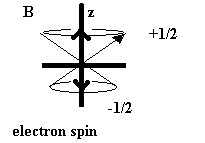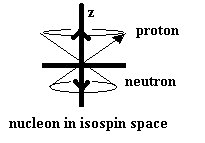Symmetries and Conservation
Laws - The Nucleus as a Laboratory
Symmetries in a system lead to conserved quantities.
Conserved quantities imply some underlying symmetry
enjoyed by the interactions.
1) Space-Time symmetries lead to conservation laws
of momentum, angular momentum, and energy.
2) What is the underlying symmetry that leads to conservation
of electric charge?
Isospin and internal symmetries
Soon after the discovery of the neutron it was realized
that neutrons and protons behaved very much the same. The forces they exerted
on each other were nearly independent of whether the interaction was between
neutrons, protons, or neutrons and protons. The electrical charge of the
protons spoils the near perfect identity of neutrons and protons.
Physicists began to think of the proton and the neutron
as different manifestations of a single particle they called the "nucleon".
The nucleon can exist in either of two states, as a proton or a neutron.
This is reminiscent of the two spin states of an electron, spin up or spin
down. Whereas the electron's spin state is determined by the projection
of its spin in real space along some axis, the isospin state of the nucleon
is determined by a projection in an abstract space.
| We define a z-axis in space by establishing a magnetic
field B. The electron is a tiny magnet that precessess about the magnetic
field. When we try to measure the projection of the electrons spin along
the z axis we discover that we can only measure two values, either along
B or anti parallel to B. These spin projections, +1/2 and -1/2 are commonly
called spin up or spin down. |
 |
The nucleon is a two state object. We define an abstract
internal space called isospin. The spin one-half nucleon is said to have
projections either along z ( the proton) or anti parallel to z
( the neutron). We must note that this picture of
an abstract internal isospin space is a convenient mathematical device.
Whatever we learn from the angular momentum algebra for electron spin we
can apply to isospin.
This picture does not explain
the dynamical origins of isospin symmetry. It was not until the discovery
of quarks that the cause of isospin symmetry was understood. |
 |
It was discovered that the isospin properties of a
pair of interacting nucleons influenced the reactions possible between
them. The nucleus could be characterized by isospin quantum numbers which
restricted the possible states in which the many nucleon system can exist.
The strong nuclear force and the electromagnetic force "conserve" isospin.
This means that the total isospin and its projection were constants of
motion if these two forces were responsible for the dynamics of the system.
The weak interaction does not conserve isospin.
The concept of isospin was important as a first step
in realizing that there were other symmetries in nature than the classical
space-time symmetries. Other internal symmetries were discovered subsequently
which helped physicists categorize reactions by the types of "quantum numbers"
that were conserved.
| Classical space-time symmetries |
classically known quantities like momentum, energy,
angular momentum are conserved |
| Internal symmetries |
quantum mechanical numbers conserved like isospin,
lepton
number, baryon number, quark flavor, parity,
charge conjugation |
Kaon decay and the violation
of parity-charge conjugation symmetry.